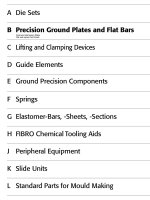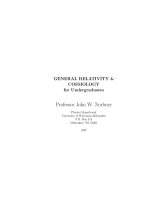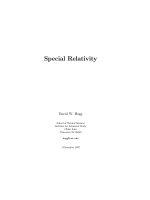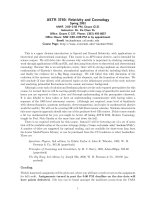Special Relativity and Flat Spacetime
Bạn đang xem bản rút gọn của tài liệu. Xem và tải ngay bản đầy đủ của tài liệu tại đây (261.49 KB, 30 trang )
December 1997 Lecture Notes on General Relativity Sean M. Carroll
1 Special Relativity and Flat Spacetime
We will begin with a whirlwind tour of special relativity (SR) and life in flat spacetime.
The point will be both to recall what SR is all about, and to introduce tensors and related
concepts that will be crucial later on, without the extra complications of curvature on top
of everything else. Therefore, for this section we will always be working in flat spacetime,
and furthermore we will only use orthonormal (Cartesian-like) coordinates. Needless to say
it is possible to do SR in any coordinate system you like, but it turns out that introducing
the necessary tools for doing so would take us halfway to curved spaces anyway, so we will
put that off for a while.
It is often said that special relativity is a theory of 4-dimensional spacetime: three of
space, one of time. But of course, the pre-SR world of Newtonian mechanics featured three
spatial dimensions and a time parameter. Nevertheless, there was not much temptation to
consider these as different aspects of a single 4-dimensional spacetime. Why not?
space at a
fixed time
t
x, y, z
Consider a garden-variety 2-dimensional plane. It is typically convenient to label the
points on such a plane by introducing coordinates, for example by defining orthogonal x and
y axes and projecting each point onto these axes in the usual way. However, it is clear that
most of the interesting geometrical facts about the plane are independent of our choice of
coordinates. As a simple example, we can consider the distance between two points, given
1
1 SPECIAL RELATIVITY AND FLAT SPACETIME 2
by
s
2
= (∆x)
2
+ (∆y)
2
. (1.1)
In a different Cartesian coordinate system, defined by x
′
and y
′
axes which are rotated with
respect to the originals, the formula for the distance is unaltered:
s
2
= (∆x
′
)
2
+ (∆y
′
)
2
. (1.2)
We therefore say that the distance is invariant under such changes of coordinates.
∆
∆
∆
y
x’
x
y
y’
x
x’
s
y’
∆
∆
This is why it is useful to think of the plane as 2-dimensional: although we use two distinct
numbers to label each point, the numbers are not the essence of the geometry, since we can
rotate axes into each other while leaving distances and so forth unchanged. In Newtonian
physics this is not the case with space and time; there is no useful notion of rotating space
and time into each other. Rather, the notion of “all of space at a single moment in time”
has a meaning independent of coordinates.
Such is not the case in SR. Let us consider coordinates (t, x, y, z) on spacetime, set up in
the following way. The spatial coordinates (x, y, z) comprise a standard Cartesian system,
constructed for example by welding together rigid rods which meet at right angles. The rods
must be moving freely, unaccelerated. The time coordinate is defined by a set of clocks which
are not moving with respect to the spatial coordinates. (Since this is a thought experiment,
we imagine that the rods are infinitely long and there is one clock at every point in space.)
The clocks are synchronized in the following sense: if you travel from one point in space to
any other in a straight line at constant speed, the time difference between the clocks at the
1 SPECIAL RELATIVITY AND FLAT SPACETIME 3
ends of your journey is the same as if you had made the same trip, at the same speed, in the
other direction. The coordinate system thus constructed is an inertial frame.
An event is defined as a single moment in space and time, characterized uniquely by
(t, x, y, z). Then, without any motivation for the moment, let us introduce the spacetime
interval between two events:
s
2
= −(c∆t)
2
+ (∆x)
2
+ (∆y)
2
+ (∆z)
2
. (1.3)
(Notice that it can be positive, negative, or zero even for two nonidentical points.) Here, c
is some fixed conversion factor between space and time; that is, a fixed velocity. Of course
it will turn out to be the speed of light; the important thing, however, is not that photons
happen to travel at that speed, but that there exists a c such that the spacetime interval
is invariant under changes of coordinates. In other words, if we set up a new inertial frame
(t
′
, x
′
, y
′
, z
′
) by repeating our earlier procedure, but allowing for an offset in initial position,
angle, and velocity between the new rods and the old, the interval is unchanged:
s
2
= −(c∆t
′
)
2
+ (∆x
′
)
2
+ (∆y
′
)
2
+ (∆z
′
)
2
. (1.4)
This is why it makes sense to think of SR as a theory of 4-dimensional spacetime, known
as Minkowski space. (This is a special case of a 4-dimensional manifold, which we will
deal with in detail later.) As we shall see, the coordinate transformations which we have
implicitly defined do, in a sense, rotate space and time into each other. There is no absolute
notion of “simultaneous events”; whether two things occur at the same time depends on the
coordinates used. Therefore the division of Minkowski space into space and time is a choice
we make for our own purposes, not something intrinsic to the situation.
Almost all of the “paradoxes” associated with SR result from a stubborn persistence of
the Newtonian notions of a unique time coordinate and the existence of “space at a single
moment in time.” By thinking in terms of spacetime rather than space and time together,
these paradoxes tend to disappear.
Let’s introduce some convenient notation. Coordinates on spacetime will be denoted by
letters with Greek superscript indices running from 0 to 3, with 0 generally denoting the
time coordinate. Thus,
x
µ
:
x
0
= ct
x
1
= x
x
2
= y
x
3
= z
(1.5)
(Don’t start thinking of the superscripts as exponents.) Furthermore, for the sake of sim-
plicity we will choose units in which
c = 1 ; (1.6)
1 SPECIAL RELATIVITY AND FLAT SPACETIME 4
we will therefore leave out factors of c in all subsequent formulae. Empirically we know that
c is the speed of light, 3×10
8
meters per second; thus, we are working in units where 1 second
equals 3×10
8
meters. Sometimes it will be useful to refer to the space and time components
of x
µ
separately, so we will use Latin superscripts to stand for the space components alone:
x
i
:
x
1
= x
x
2
= y
x
3
= z
(1.7)
It is also convenient to write the spacetime interval in a more compact form. We therefore
introduce a 4 × 4 matrix, the metric, which we write using two lower indices:
η
µν
=
−1 0 0 0
0 1 0 0
0 0 1 0
0 0 0 1
. (1.8)
(Some references, especially field theory books, define the metric with the opposite sign, so
be careful.) We then have the nice formula
s
2
= η
µν
∆x
µ
∆x
ν
. (1.9)
Notice that we use the summation convention, in which indices which appear both as
superscripts and subscripts are summed over. The content of (1.9) is therefore just the same
as (1.3).
Now we can consider coordinate transformations in spacetime at a somewhat more ab-
stract level than before. What kind of transformations leave the interval (1.9) invariant?
One simple variety are the translations, which merely shift the coordinates:
x
µ
→ x
µ
′
= x
µ
+ a
µ
, (1.10)
where a
µ
is a set of four fixed numbers. (Notice that we put the prime on the index, not on
the x.) Translations leave the differences ∆x
µ
unchanged, so it is not remarkable that the
interval is unchanged. The only other kind of linear transformation is to multiply x
µ
by a
(spacetime-independent) matrix:
x
µ
′
= Λ
µ
′
ν
x
ν
, (1.11)
or, in more conventional matrix notation,
x
′
= Λx . (1.12)
These transformations do not leave the differences ∆x
µ
unchanged, but multiply them also
by the matrix Λ. What kind of matrices will leave the interval invariant? Sticking with the
matrix notation, what we would like is
s
2
= (∆x)
T
η(∆x) = (∆x
′
)
T
η(∆x
′
)
= (∆x)
T
Λ
T
ηΛ(∆x) , (1.13)
1 SPECIAL RELATIVITY AND FLAT SPACETIME 5
and therefore
η = Λ
T
ηΛ , (1.14)
or
η
ρσ
= Λ
µ
′
ρ
Λ
ν
′
σ
η
µ
′
ν
′
. (1.15)
We want to find the matrices Λ
µ
′
ν
such that the components of the matrix η
µ
′
ν
′
are the
same as those of η
ρσ
; that is what it means for the interval to be invariant under these
transformations.
The matrices which satisfy (1.14) are known as the Lorentz transformations; the set
of them forms a group under matrix multiplication, known as the Lorentz group. There is
a close analogy between this group and O(3), the rotation group in three-dimensional space.
The rotation group can be thought of as 3 × 3 matrices R which satisfy
1 = R
T
1R , (1.16)
where 1 is the 3 × 3 identity matrix. The similarity with (1.14) should be clear; the only
difference is the minus sign in the first term of the metric η, signifying the timelike direction.
The Lorentz group is therefore often referred to as O(3,1). (The 3 × 3 identity matrix is
simply the metric for ordinary flat space. Such a metric, in which all of the eigenvalues are
positive, is called Euclidean, while those such as (1.8) which feature a single minus sign are
called Lorentzian.)
Lorentz transformations fall into a number of categories. First there are the conventional
rotations, such as a rotation in the x-y plane:
Λ
µ
′
ν
=
1 0 0 0
0 cos θ sin θ 0
0 − sin θ cos θ 0
0 0 0 1
. (1.17)
The rotation angle θ is a periodic variable with period 2π. There are also boosts, which
may be thought of as “rotations between space and time directions.” An example is given
by
Λ
µ
′
ν
=
cosh φ − sinh φ 0 0
− sinh φ cosh φ 0 0
0 0 1 0
0 0 0 1
. (1.18)
The boost parameter φ, unlike the rotation angle, is defined from −∞ to ∞. There are
also discrete transformations which reverse the time direction or one or more of the spa-
tial directions. (When these are excluded we have the proper Lorentz group, SO(3,1).) A
general transformation can be obtained by multiplying the individual transformations; the
1 SPECIAL RELATIVITY AND FLAT SPACETIME 6
explicit expression for this six-parameter matrix (three boosts, three rotations) is not suffi-
ciently pretty or useful to bother writing down. In general Lorentz transformations will not
commute, so the Lorentz group is non-abelian. The set of both translations and Lorentz
transformations is a ten-parameter non-abelian group, the Poincar´e group.
You should not be surprised to learn that the boosts correspond to changing coordinates
by moving to a frame which travels at a constant velocity, but let’s see it more explicitly.
For the transformation given by (1.18), the transformed coordinates t
′
and x
′
will be given
by
t
′
= t cosh φ − x sinh φ
x
′
= −t sinh φ + x cosh φ . (1.19)
From this we see that the point defined by x
′
= 0 is moving; it has a velocity
v =
x
t
=
sinh φ
cosh φ
= tanh φ . (1.20)
To translate into more pedestrian notation, we can replace φ = tanh
−1
v to obtain
t
′
= γ(t − vx)
x
′
= γ(x − vt) (1.21)
where γ = 1/
√
1− v
2
. So indeed, our abstract approach has recovered the conventional
expressions for Lorentz transformations. Applying these formulae leads to time dilation,
length contraction, and so forth.
An extremely useful tool is the spacetime diagram, so let’s consider Minkowski space
from this point of view. We can begin by portraying the initial t and x axes at (what are
conventionally thought of as) right angles, and suppressing the y and z axes. Then according
to (1.19), under a boost in the x-t plane the x
′
axis (t
′
= 0) is given by t = x tanh φ, while
the t
′
axis (x
′
= 0) is given by t = x/ tanh φ. We therefore see that the space and time axes
are rotated into each other, although they scissor together instead of remaining orthogonal
in the traditional Euclidean sense. (As we shall see, the axes do in fact remain orthogonal
in the Lorentzian sense.) This should come as no surprise, since if spacetime behaved just
like a four-dimensional version of space the world would be a very different place.
It is also enlightening to consider the paths corresponding to travel at the speed c = 1.
These are given in the original coordinate system by x = ±t. In the new system, a moment’s
thought reveals that the paths defined by x
′
= ±t
′
are precisely the same as those defined
by x = ±t; these trajectories are left invariant under Lorentz transformations. Of course
we know that light travels at this speed; we have therefore found that the speed of light is
the same in any inertial frame. A set of points which are all connected to a single event by
1 SPECIAL RELATIVITY AND FLAT SPACETIME 7
x’
x
t
t’
x = -t
x’ = -t’
x = t
x’ = t’
straight lines moving at the speed of light is called a light cone; this entire set is invariant
under Lorentz transformations. Light cones are naturally divided into future and past; the
set of all points inside the future and past light cones of a point p are called timelike
separated from p, while those outside the light cones are spacelike separated and those
on the cones are lightlike or null separated from p. Referring back to (1.3), we see that the
interval between timelike separated points is negative, between spacelike separated points is
positive, and between null separated points is zero. (The interval is defined to be s
2
, not the
square root of this quantity.) Notice the distinction between this situation and that in the
Newtonian world; here, it is impossible to say (in a coordinate-independent way) whether a
point that is spacelike separated from p is in the future of p, the past of p, or “at the same
time”.
To probe the structure of Minkowski space in more detail, it is necessary to introduce
the concepts of vectors and tensors. We will start with vectors, which should be familiar. Of
course, in spacetime vectors are four-dimensional, and are often referred to as four-vectors.
This turns out to make quite a bit of difference; for example, there is no such thing as a
cross product between two four-vectors.
Beyond the simple fact of dimensionality, the most important thing to emphasize is that
each vector is located at a given point in spacetime. You may be used to thinking of vectors
as stretching from one point to another in space, and even of “free” vectors which you can
slide carelessly from point to point. These are not useful concepts in relativity. Rather, to
each point p in spacetime we associate the set of all possible vectors located at that point;
this set is known as the tangent space at p, or T
p
. The name is inspired by thinking of the
set of vectors attached to a point on a simple curved two-dimensional space as comprising a
1 SPECIAL RELATIVITY AND FLAT SPACETIME 8
plane which is tangent to the point. But inspiration aside, it is important to think of these
vectors as being located at a single point, rather than stretching from one point to another.
(Although this won’t stop us from drawing them as arrows on spacetime diagrams.)
p
manifold
M
T
p
Later we will relate the tangent space at each point to things we can construct from the
spacetime itself. For right now, just think of T
p
as an abstract vector space for each point
in spacetime. A (real) vector space is a collection of objects (“vectors”) which, roughly
speaking, can be added together and multiplied by real numbers in a linear way. Thus, for
any two vectors V and W and real numbers a and b, we have
(a + b)(V + W ) = aV + bV + aW + bW . (1.22)
Every vector space has an origin, i.e. a zero vector which functions as an identity element
under vector addition. In many vector spaces there are additional operations such as taking
an inner (dot) product, but this is extra structure over and above the elementary concept of
a vector space.
A vector is a perfectly well-defined geometric object, as is a vector field, defined as a
set of vectors with exactly one at each point in spacetime. (The set of all the tangent spaces
of a manifold M is called the tangent bundle, T (M).) Nevertheless it is often useful for
concrete purposes to decompose vectors into components with respect to some set of basis
vectors. A basis is any set of vectors which both spans the vector space (any vector is
a linear combination of basis vectors) and is linearly independent (no vector in the basis
is a linear combination of other basis vectors). For any given vector space, there will be
an infinite number of legitimate bases, but each basis will consist of the same number of
1 SPECIAL RELATIVITY AND FLAT SPACETIME 9
vectors, known as the dimension of the space. (For a tangent space associated with a point
in Minkowski space, the dimension is of course four.)
Let us imagine that at each tangent space we set up a basis of four vectors ˆe
(µ)
, with
µ ∈ {0, 1, 2, 3} as usual. In fact let us say that each basis is adapted to the coordinates x
µ
;
that is, the basis vector ˆe
(1)
is what we would normally think of pointing along the x-axis,
etc. It is by no means necessary that we choose a basis which is adapted to any coordinate
system at all, although it is often convenient. (We really could be more precise here, but
later on we will repeat the discussion at an excruciating level of precision, so some sloppiness
now is forgivable.) Then any abstract vector A can be written as a linear combination of
basis vectors:
A = A
µ
ˆe
(µ)
. (1.23)
The coefficients A
µ
are the components of the vector A. More often than not we will forget
the basis entirely and refer somewhat loosely to “the vector A
µ
”, but keep in mind that
this is shorthand. The real vector is an abstract geometrical entity, while the components
are just the coefficients of the basis vectors in some convenient basis. (Since we will usually
suppress the explicit basis vectors, the indices will usually label components of vectors and
tensors. This is why there are parentheses around the indices on the basis vectors, to remind
us that this is a collection of vectors, not components of a single vector.)
A standard example of a vector in spacetime is the tangent vector to a curve. A param-
eterized curve or path through spacetime is specified by the coordinates as a function of the
parameter, e.g. x
µ
(λ). The tangent vector V (λ) has components
V
µ
=
dx
µ
dλ
. (1.24)
The entire vector is thus V = V
µ
ˆe
(µ)
. Under a Lorentz transformation the coordinates
x
µ
change according to (1.11), while the parameterization λ is unaltered; we can therefore
deduce that the components of the tangent vector must change as
V
µ
→ V
µ
′
= Λ
µ
′
ν
V
ν
. (1.25)
However, the vector itself (as opposed to its components in some coordinate system) is
invariant under Lorentz transformations. We can use this fact to derive the transformation
properties of the basis vectors. Let us refer to the set of basis vectors in the transformed
coordinate system as ˆe
(ν
′
)
. Since the vector is invariant, we have
V = V
µ
ˆe
(µ)
= V
ν
′
ˆe
(ν
′
)
= Λ
ν
′
µ
V
µ
ˆe
(ν
′
)
. (1.26)
But this relation must hold no matter what the numerical values of the components V
µ
are.
Therefore we can say
ˆe
(µ)
= Λ
ν
′
µ
ˆe
(ν
′
)
. (1.27)
1 SPECIAL RELATIVITY AND FLAT SPACETIME 10
To get the new basis ˆe
(ν
′
)
in terms of the old one ˆe
(µ)
we should multiply by the inverse
of the Lorentz transformation Λ
ν
′
µ
. But the inverse of a Lorentz transformation from the
unprimed to the primed coordinates is also a Lorentz transformation, this time from the
primed to the unprimed systems. We will therefore introduce a somewhat subtle notation,
by writing using the same symbol for both matrices, just with primed and unprimed indices
adjusted. That is,
(Λ
−1
)
ν
′
µ
= Λ
ν
′
µ
, (1.28)
or
Λ
ν
′
µ
Λ
σ
′
µ
= δ
σ
′
ν
′
, Λ
ν
′
µ
Λ
ν
′
ρ
= δ
µ
ρ
, (1.29)
where δ
µ
ρ
is the traditional Kronecker delta symbol in four dimensions. (Note that Schutz uses
a different convention, always arranging the two indices northwest/southeast; the important
thing is where the primes go.) From (1.27) we then obtain the transformation rule for basis
vectors:
ˆe
(ν
′
)
= Λ
ν
′
µ
ˆe
(µ)
. (1.30)
Therefore the set of basis vectors transforms via the inverse Lorentz transformation of the
coordinates or vector components.
It is worth pausing a moment to take all this in. We introduced coordinates labeled by
upper indices, which transformed in a certain way under Lorentz transformations. We then
considered vector components which also were written with upper indices, which made sense
since they transformed in the same way as the coordinate functions. (In a fixed coordinate
system, each of the four coordinates x
µ
can be thought of as a function on spacetime, as
can each of the four components of a vector field.) The basis vectors associated with the
coordinate system transformed via the inverse matrix, and were labeled by a lower index.
This notation ensured that the invariant object constructed by summing over the components
and basis vectors was left unchanged by the transformation, just as we would wish. It’s
probably not giving too much away to say that this will continue to be the case for more
complicated objects with multiple indices (tensors).
Once we have set up a vector space, there is an associated vector space (of equal dimen-
sion) which we can immediately define, known as the dual vector space. The dual space
is usually denoted by an asterisk, so that the dual space to the tangent space T
p
is called
the cotangent space and denoted T
∗
p
. The dual space is the space of all linear maps from
the original vector space to the real numbers; in math lingo, if ω ∈ T
∗
p
is a dual vector, then
it acts as a map such that:
ω(aV + bW ) = aω(V ) + bω(W ) ∈ R , (1.31)
where V , W are vectors and a, b are real numbers. The nice thing about these maps is that
they form a vector space themselves; thus, if ω and η are dual vectors, we have
(aω + bη)(V ) = aω(V ) + bη(V ) . (1.32)
1 SPECIAL RELATIVITY AND FLAT SPACETIME 11
To make this construction somewhat more concrete, we can introduce a set of basis dual
vectors
ˆ
θ
(ν)
by demanding
ˆ
θ
(ν)
(ˆe
(µ)
) = δ
ν
µ
. (1.33)
Then every dual vector can be written in terms of its components, which we label with lower
indices:
ω = ω
µ
ˆ
θ
(µ)
. (1.34)
In perfect analogy with vectors, we will usually simply write ω
µ
to stand for the entire dual
vector. In fact, you will sometime see elements of T
p
(what we have called vectors) referred to
as contravariant vectors, and elements of T
∗
p
(what we have called dual vectors) referred
to as covariant vectors. Actually, if you just refer to ordinary vectors as vectors with upper
indices and dual vectors as vectors with lower indices, nobody should be offended. Another
name for dual vectors is one-forms, a somewhat mysterious designation which will become
clearer soon.
The component notation leads to a simple way of writing the action of a dual vector on
a vector:
ω(V ) = ω
µ
V
ν
ˆ
θ
(µ)
(ˆe
(ν)
)
= ω
µ
V
ν
δ
µ
ν
= ω
µ
V
µ
∈ R . (1.35)
This is why it is rarely necessary to write the basis vectors (and dual vectors) explicitly; the
components do all of the work. The form of (1.35) also suggests that we can think of vectors
as linear maps on dual vectors, by defining
V (ω) ≡ ω(V ) = ω
µ
V
µ
. (1.36)
Therefore, the dual space to the dual vector space is the original vector space itself.
Of course in spacetime we will be interested not in a single vector space, but in fields of
vectors and dual vectors. (The set of all cotangent spaces over M is the cotangent bundle,
T
∗
(M).) In that case the action of a dual vector field on a vector field is not a single number,
but a scalar (or just “function”) on spacetime. A scalar is a quantity without indices, which
is unchanged under Lorentz transformations.
We can use the same arguments that we earlier used for vectors to derive the transfor-
mation properties of dual vectors. The answers are, for the components,
ω
µ
′
= Λ
µ
′
ν
ω
ν
, (1.37)
and for basis dual vectors,
ˆ
θ
(ρ
′
)
= Λ
ρ
′
σ
ˆ
θ
(σ)
. (1.38)
1 SPECIAL RELATIVITY AND FLAT SPACETIME 12
This is just what we would expect from index placement; the components of a dual vector
transform under the inverse transformation of those of a vector. Note that this ensures that
the scalar (1.35) is invariant under Lorentz transformations, just as it should be.
Let’s consider some examples of dual vectors, first in other contexts and then in Minkowski
space. Imagine the space of n-component column vectors, for some integer n. Then the dual
space is that of n-component row vectors, and the action is ordinary matrix multiplication:
V =
V
1
V
2
·
·
·
V
n
, ω = (ω
1
ω
2
··· ω
n
) ,
ω(V ) = (ω
1
ω
2
··· ω
n
)
V
1
V
2
·
·
·
V
n
= ω
i
V
i
. (1.39)
Another familiar example occurs in quantum mechanics, where vectors in the Hilbert space
are represented by kets, |ψ. In this case the dual space is the space of bras, φ|, and the
action gives the number φ|ψ. (This is a complex number in quantum mechanics, but the
idea is precisely the same.)
In spacetime the simplest example of a dual vector is the gradient of a scalar function,
the set of partial derivatives with respect to the spacetime coordinates, which we denote by
“d”:
dφ =
∂φ
∂x
µ
ˆ
θ
(µ)
. (1.40)
The conventional chain rule used to transform partial derivatives amounts in this case to the
transformation rule of components of dual vectors:
∂φ
∂x
µ
′
=
∂x
µ
∂x
µ
′
∂φ
∂x
µ
= Λ
µ
′
µ
∂φ
∂x
µ
, (1.41)
where we have used (1.11) and (1.28) to relate the Lorentz transformation to the coordinates.
The fact that the gradient is a dual vector leads to the following shorthand notations for
partial derivatives:
∂φ
∂x
µ
= ∂
µ
φ = φ,
µ
. (1.42)









